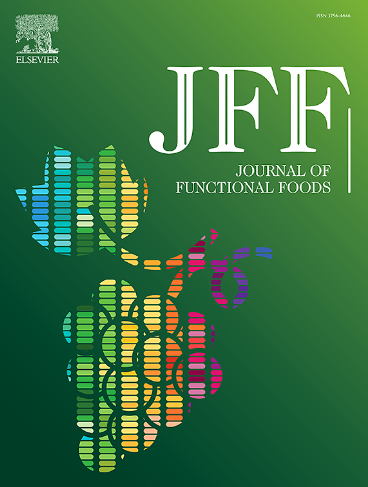An overview of bovine beta-casomorphin-7 (b-BCM7) and its potential impact on microbiota regulation and digestive health
IF 3.8
2区 农林科学
Q2 FOOD SCIENCE & TECHNOLOGY
引用次数: 0
Abstract
This review explores the global production and consumption of bovine milk, highlighting its role in human nutrition. Cow's milk production contributes to household income, food security, and provides essential nutrients (Protein 3.2 %, Fat 3,8 %, Carbohydrates 4,5 %, Calcium 0,12 %, Vitamin B6, B12, D, and C), with over 6 billion people consuming it worldwide. Milk has evolved to meet consumer needs, leading to variations such as lactose-free, skim, and fortified milk. Similarly, the differentiation between A1 and A2 milk has emerged in response to growing interest in their potential health effects. Recent research distinguishes milk based on its β-casein (β-CN) composition, particularly the A1 and A2 variants, which differ in digestion due to the release of bioactive peptides like bovine β-casomorphin-7 (b-BCM7). The amount of b-BCM7 released depends on the β-CN type, with the A1 variant linked to potential effects on the digestive, neurological, and immunological systems, potentially affecting, for example, gut motility and inflammatory responses. However, the microbiota is now recognized as a dynamic organ that contributes to bio-individuality, meaning health effects cannot be generalized. This underscores the importance of alternatives such as A2 milk, which releases less b-BCM7 and is believed to have no adverse effects. Despite concerns, milk remains a nutrient-dense superfood often discouraged in modern diets, potentially depriving people of its benefits. Further research is essential to understand the production of b-BCM7 during digestion and its health effects, clarifying whether its impact occurs during digestion and absorption or directly influences microbiota regulation, helping to provide clearer dietary recommendations.

牛β -酪啡肽-7 (b-BCM7)及其对微生物群调节和消化系统健康的潜在影响综述
这篇综述探讨了全球牛奶的生产和消费,强调了它在人类营养中的作用。牛奶生产有助于家庭收入、粮食安全,并提供必需营养素(蛋白质3.2%、脂肪3.8%、碳水化合物4.5%、钙0.12%、维生素B6、B12、D和C),全球有超过60亿人食用牛奶。为了满足消费者的需求,牛奶已经发生了变化,导致了诸如无乳糖、脱脂和强化牛奶等变化。同样,A1和A2牛奶之间的区别也出现在人们对它们潜在的健康影响日益增长的兴趣中。最近的研究根据其β-酪蛋白(β-CN)组成来区分牛奶,特别是A1和A2变体,由于释放生物活性肽如牛β-酪啡肽-7 (b-BCM7),它们在消化过程中不同。b-BCM7的释放量取决于β-CN类型,A1变体与消化系统、神经系统和免疫系统的潜在影响有关,例如可能影响肠道运动和炎症反应。然而,微生物群现在被认为是一个动态的器官,有助于生物个性,这意味着健康影响不能一概而论。这强调了A2牛奶等替代品的重要性,A2牛奶释放的b-BCM7较少,据信没有副作用。尽管存在担忧,但牛奶仍然是一种营养丰富的超级食品,在现代饮食中往往不受欢迎,这可能会剥夺人们对牛奶的益处。为了了解消化过程中b-BCM7的产生及其对健康的影响,阐明其影响是发生在消化和吸收过程中,还是直接影响微生物群的调节,进一步的研究至关重要,有助于提供更清晰的饮食建议。
本文章由计算机程序翻译,如有差异,请以英文原文为准。
求助全文
约1分钟内获得全文
求助全文
来源期刊

Journal of Functional Foods
FOOD SCIENCE & TECHNOLOGY-
CiteScore
9.60
自引率
1.80%
发文量
428
审稿时长
76 days
期刊介绍:
Journal of Functional Foods continues with the same aims and scope, editorial team, submission system and rigorous peer review. We give authors the possibility to publish their top-quality papers in a well-established leading journal in the food and nutrition fields. The Journal will keep its rigorous criteria to screen high impact research addressing relevant scientific topics and performed by sound methodologies.
The Journal of Functional Foods aims to bring together the results of fundamental and applied research into healthy foods and biologically active food ingredients.
The Journal is centered in the specific area at the boundaries among food technology, nutrition and health welcoming papers having a good interdisciplinary approach. The Journal will cover the fields of plant bioactives; dietary fibre, probiotics; functional lipids; bioactive peptides; vitamins, minerals and botanicals and other dietary supplements. Nutritional and technological aspects related to the development of functional foods and beverages are of core interest to the journal. Experimental works dealing with food digestion, bioavailability of food bioactives and on the mechanisms by which foods and their components are able to modulate physiological parameters connected with disease prevention are of particular interest as well as those dealing with personalized nutrition and nutritional needs in pathological subjects.
 求助内容:
求助内容: 应助结果提醒方式:
应助结果提醒方式:


